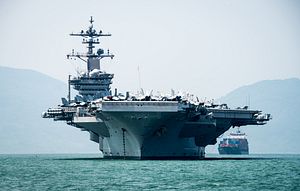While much ink has been spilled about China’s exclusion from the 2018 iteration of the Rim of the Pacific (RIMPAC) exercise, the world’s largest international maritime exercise, Vietnam’s inaugural inclusion in the exercise deserves attention as well. Hanoi’s first foray into RIMPAC, which kicked off on July 1 and will last till July 31, bears noting given the other developments in U.S.-Vietnam relations under U.S. President Donald Trump and the furthering of Washington’s new Free and Open Indo Pacific Strategy (FOIPS).
Vietnam’s involvement in RIMPAC, which takes place biennially in the summer months in waters around the Hawaiian Islands and southern California, is not new. Hanoi sent observers to RIMPAC in both 2012 and 2016, as other Southeast Asian countries have done previously as well on a small scale.
But Vietnam’s full participation this year is a first, along with Brazil, Israel, and Sri Lanka. According to Vietnam’s defense ministry, Hanoi is sending eight naval officers to RIMPAC at the invitation of the Commander of the U.S. Navy’s Pacific Fleet.
Vietnam’s defense ministry has cast the participation as an opportunity for Vietnam’s naval forces to learn from other countries’ experiences and improve in specific areas such as disaster relief and search and rescue. And that is no doubt significant in and of itself.
But the development also carries broader strategic significance when viewed alongside other developments as well beyond just this single activity. For one, Vietnam’s RIMPAC participation comes amid an uptick in defense activity between Washington and Hanoi in recent years (See: “US-Vietnam Defense Relations: Opportunities and Challenges”).
That has continued on and in some respects accelerated under the Trump administration, despite lingering uncertainties and challenges (See: “What’s Next for U.S.-Vietnam Defense Ties Under Trump?”). As the administration has looked to build out its free and open Indo-Pacific strategy, Vietnam has been seen as a key partner in this respect (See: “Trump’s Indo-Pacific Strategy Challenge in the Spotlight at 2018 Shangri-La Dialogue”).
Beyond the bilateral relationship, Vietnam’s RIMPAC 2018 participation also bears significance as part of the broader question of the extent of Southeast Asian involvement in U.S. exercises. Beyond Vietnam, six other Southeast Asian countries are participating in RIMPAC this year: Brunei, Indonesia, Malaysia, the Philippines, Singapore, Thailand.
Apart from sheer participation itself, the degree of involvement is also worth emphasizing here as I have observed before. For instance, it is additionally notable that of those, four of them – Indonesia, Malaysia, the Philippines, and Singapore – who have previously participated are sending ships to RIMPAC when they have not necessarily done so before (See: “A First: Malaysia to Deploy Warships for RIMPAC 2018”).
Vietnam was a participant but did not send vessels to RIMPAC this year. Nonetheless, both for its own sake as well as within the context of these broader trends and developments, Hanoi’s inclusion still merits noting.
































